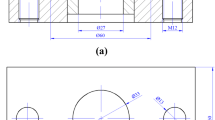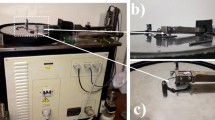Abstract
The purpose of this work is to explore the mechanism of lubricants containing TiO2 nanoparticles to improve tribological properties and the effect of nanoparticle lubrication on precision forming. Firstly, the friction coefficients, wear rates, and average surface roughness for different concentration of TiO2 nanoparticle in lubricants are obtained from friction and wear tests. It is found that when the TiO2 concentration is 0.1wt%, the surface roughness of the sample reaches the lowest, while the surface roughness is higher under the lubricant of 0.5wt% nanoparticles which is ideal for friction coefficient and wear. Then, the effect of adhesion which mainly occurs when using lubricant containing no nanoparticles on the workpiece surface roughness is analyzed, including the joint action of height reduction of the micro-convex peak and the root roughening. Mechanism of lubricants containing TiO2 nanoparticles to improve tribological properties is presented, in which the wear and morphology evolution of workpiece surface are influenced by the coupling of tip adhesion and nanoparticle smoothing. Meanwhile the addition of nanoparticles can inhibit the adhesive wear of the tip, the effect of which is enhanced with the increase of TiO2 particle concentration. This explains why the surface roughness is higher and the friction coefficient and wear are minimal when the content of TiO2 nanoparticle is 0.5wt%. Finally, the effect of TiO2 nanoparticle lubrication on precision forming, including the metal flow, the forming load, and the error tolerance, is discussed. This work will help to further promote the development of precision forming technology.


















Similar content being viewed by others
References
Ajiboye JS, Adeyemi MB (2006) Upper bound analysis of die land length in cold extrusion. J Mater Process Technol 177:608–611. https://doi.org/10.1016/j.jmatprotec.2006.04.030
Ajiboye JS, Adeyemi MB (2006) Effects of die land on the cold extrusion of lead alloy. J Mater Process Technol 171:428–436. https://doi.org/10.1016/j.jmatprotec.2005.08.004
Zhou W, Lin J, Dean TA, Wang L (2018) Feasibility studies of a novel extrusion process for curved profiles: experimentation and modelling. Int J Mach Tools Manuf 126:27–43. https://doi.org/10.1016/j.ijmachtools.2017.12.001
Soussi H, Masmoudi N, Krichen A (2016) Analysis of geometrical parameters and occurrence of defects in the hole-flanging process on thin sheet metal. J Mater Process Technol 234:228–242. https://doi.org/10.1016/j.jmatprotec.2016.03.027
Mori K, Abe Y, Osakada K, Hiramatsu S (2011) Plate forging of tailored blanks having local thickening for deep drawing of square cups. J Mater Process Technol 211:1569–1574. https://doi.org/10.1016/j.jmatprotec.2011.04.010
Li HY, Xia M, Zhao Z, Zheng Y (2013) An experimental study on local thickening laws based on multi-plate extrusion. J Mater Process Technol 213:1213–1220. https://doi.org/10.1016/j.jmatprotec.2013.01.014
Sorine M, Simha CHM, van Riemsdijk I, Worswick MJ (2008) Prediction of necking of high strength steel tubes during hydroforming—multi-axial loading. Int J Mech Sci 50:1411–1422. https://doi.org/10.1016/j.ijmecsci.2008.07.003
Güler B, Efe M (2018) Forming and fracture limits of sheet metals deforming without a local neck. J Mater Process Technol 252:477–484. https://doi.org/10.1016/j.jmatprotec.2017.10.004
Abe Y, Mori K, Hatashita F, Shiba T, Daodon W, Osakada K (2016) Improvement of seizure resistance in ironing of stainless steel cup with cermet die having fine lubricant pockets. J Mater Process Technol 234:195–207. https://doi.org/10.1016/j.jmatprotec.2016.03.017
Chekmarev AP, Klimenko PA, Vinogradov GA (1963) Investigation of specific pressure, specific friction, and the coefficient of friction during metal powder rolling. Sov Powder Metall Met Ceram 2:112–115. https://doi.org/10.1007/BF01111823
McConnell C, Lenard JG (2000) Friction in cold rolling of a low carbon steel with lubricants. J Mater Process Technol 99:86–93. https://doi.org/10.1016/S0924-0136(99)00391-X
Patir N, Cheng HS (1979) Application of average flow model to lubrication between rough sliding surfaces. J Lubr Technol 101:220. https://doi.org/10.1115/1.3453329
Mezher MT, Saad ML, Barrak OS, Shakir RA (2020) Finite element simulation and experimental analysis of nano powder additives effect in the deep drawing process. Int J Mech Mechatron Eng 20:166–180
Tarasov S, Kolubaev A, Belyaev S, Lerner M, Tepper F (2002) Study of friction reduction by nanocopper additives to motor oil. Wear 252:63–69. https://doi.org/10.1016/S0043-1648(01)00860-2
Guo ZQ, Zhang YJ, Wang JC, Gao CP, Zhang SM, Zhang PY, Zhang ZJ (2020) Interactions of Cu nanoparticles with conventional lubricant additives on tribological performance and some physicochemical properties of an ester base oil. Tribol Int 141:105941. https://doi.org/10.1016/j.triboint.2019.105941
Saffari HRM, Soltani R, Alaei M, Soleymani M (2018) Tribological properties of water-based drilling fluids with borate nanoparticles as lubricant additives. J Pet Sci Eng 171:253–259. https://doi.org/10.1016/j.petrol.2018.07.049
Kim H, Sung JH, Sivakumar R, Altan T (2007) Evaluation of stamping lubricants using the deep drawing test. Int J Mach Tools Manuf 47:2120–2132. https://doi.org/10.1016/j.ijmachtools.2007.04.014
Xue QJ, Liu WM, Zhang ZJ (1997) Friction and wear properties of a surface-modified TiO2 nanoparticle as an additive in liquid paraffin. Wear 213:29–32. https://doi.org/10.1016/S0043-1648(97)00200-7
Sun JL, Zhu ZX, Xu PF (2015) Study on the lubricating performance of nano-TiO2 in water-based cold rolling fluid. Mater Sci Forum 817:219–224. https://doi.org/10.4028/www.scientific.net/msf.817.219
Wu H, Zhao JW, Xia WZ, Cheng XW, He AS (2017) A study of the tribological behaviour of TiO2 nano-additive water-based lubricants. Tribol Int 109:398–408. https://doi.org/10.1016/j.triboint.2017.01.013
Kamali H, Xie HB, Jia FH et al (2019) Effects of nano-particle lubrication on micro deep drawing of Mg-Li alloy. Int J Adv Manuf Technol. https://doi.org/10.1007/s00170-019-04267-z
Tan CJ, Abe Y, Daodon W, Takahashi N, Mori K, Purbolaksono J (2016) Increase in ironing limit of aluminium alloy cups with lubricants containing nanoparticles. J Mater Process Technol 229:804–813. https://doi.org/10.1016/j.jmatprotec.2015.10.032
Le HR, Sutcliffe MPF (2003) Evolution of surface pits on stainless steel strip in cold rolling and strip drawing. J Tribol-Trans ASME 125:384–390. https://doi.org/10.1115/1.1504088
Sutcliffe MPF, Le HR, Ahmed R (2001) Modeling of micro-pit evolution in rolling or strip-drawing. J Tribol Trans ASME 123:791–798. https://doi.org/10.1115/1.1352741
Huang SQ, Lin WK, Li XL, Fan ZQ, Wu H, Jiang ZY, Huang H (2021) Roughness-dependent tribological characteristics of water-based GO suspensions with ZrO2 and TiO2 nanoparticles as additives. Tribol Int 161:107073. https://doi.org/10.1016/j.triboint.2021.107073
Liñeira del Río JM, Mariño F, López ER, Gonçalves DE, Seabra JO, Fernández J (2023) Tribological enhancement of potential electric vehicle lubricants using coated TiO2 nanoparticles as additives. J Mol Liq 371:121097. https://doi.org/10.1016/j.molliq.2022.121097
Xia WZ, Zhao JW, Wu H et al (2018) Effects of oil-in-water based nanolubricant containing TiO2 nanoparticles in hot rolling of 304 stainless steel. J Mater Process Technol 262:149–156. https://doi.org/10.1016/j.jmatprotec.2018.06.020
Wang L, Tieu AK, Zhu HT, Deng GY, Cui SG, Zhu Q (2021) A study of water-based lubricant with a mixture of polyphosphate and nano-TiO2 as additives for hot rolling process. Wear 477:203895. https://doi.org/10.1016/j.wear.2021.203895
Funding
This work was supported by the National Natural Science Foundation of China (Grant No. 51975072).
Author information
Authors and Affiliations
Contributions
Dan Xie: conception, design, investigation, methodology, analysis, writing (original draft and revision). Qiuyue Ouyang: software and data collection. Luoyu He: experiment and data processing. Wujiao Xu: supervision, project administration methodology, writing (review and editing).
Corresponding author
Ethics declarations
Competing interests
The authors declare no competing interests.
Additional information
Publisher's note
Springer Nature remains neutral with regard to jurisdictional claims in published maps and institutional affiliations.
Rights and permissions
Springer Nature or its licensor (e.g. a society or other partner) holds exclusive rights to this article under a publishing agreement with the author(s) or other rightsholder(s); author self-archiving of the accepted manuscript version of this article is solely governed by the terms of such publishing agreement and applicable law.
About this article
Cite this article
Xie, D., Ouyang, Q., He, L. et al. Effect of TiO2 nanoparticle lubrication on precision forming. Int J Adv Manuf Technol 127, 2581–2594 (2023). https://doi.org/10.1007/s00170-023-11688-4
Received:
Accepted:
Published:
Issue Date:
DOI: https://doi.org/10.1007/s00170-023-11688-4




